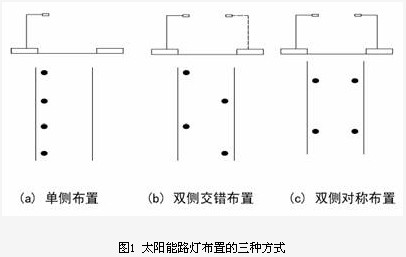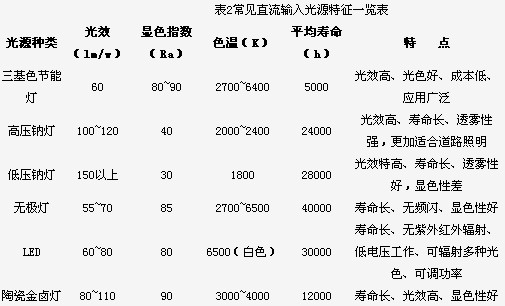Solar road lighting device is a lighting device that uses solar energy as an energy source. Because it is not affected by the mains power supply, it does not need to ditch the buried wire or overhead wires, does not consume conventional electric energy, and can be installed on site if the sun is sufficient. Received widespread attention. The main application of solar road lighting is solar street lighting. It is widely used in rural tourism roads, urban and rural areas combined with highways, remote mountainous areas, etc. It is especially suitable for installation in remote mountainous areas with inconvenient transportation and areas that are inconvenient to access to municipal power, and has broad market prospects.
1 Reference standard for solar street lighting
Due to the limitation of various aspects of the system, the lighting of solar street lamps cannot be required according to the lighting standards of the mains. At present, some local standards can be used for reference, such as the local standard “Technical Requirements for Solar Photovoltaic Outdoor Lighting†(DB11/). T542-2008), which specifies the lighting standards: the average illumination of rural street and road maintenance level is 3-4lx, the uniformity of horizontal illumination is 0.1~0.2, and the type of lamps adopts half-cut type lamps.
2 solar street light design
2.1 Site survey
Solar streetlights use solar radiation to generate electricity. They have special requirements for the specific location of streetlight installation. The solar streetlights must be site surveyed before installation. The contents of the survey mainly include:
1. Check whether there are trees, buildings, etc. on both sides of the road (mainly on the south or east and west sides) of the installation road. If there are trees or buildings that may block the lighting, measure the height and the distance from the installation site. Determine whether it affects the lighting of solar modules; the general requirement for solar lighting is that solar lighting can at least ensure that there is no occlusion that affects daylighting between 9:00 am and 3:00 pm.
2. Observe whether there are cables, wires or other facilities that affect the installation of the lamps above the installation position of the solar lamps (Note: It is strictly forbidden to install solar lamps under the high-voltage lines);
3. Understand whether there are cables, optical cables, pipelines or other facilities affecting construction in the base of solar street lamps and battery compartments, and whether there are signs prohibiting construction. When installing, try to avoid the above facilities. If you can't avoid it, please contact the relevant department and negotiate to agree to the construction.
4. Avoid installation in low-lying areas that are prone to water accumulation;
5. Take photos on site at the installation site;
6. Measure the width, length, occlusion height and distance parameters of the road segment, record the road direction and provide it to the plan designer for reference.
2.2 Installation and layout
1. According to the width of the road and the lighting requirements, choose to install the lighting method:
a, single-sided arrangement b, bilaterally symmetric arrangement;
c, double-sided staggered arrangement

2. The length of the cantilever of the luminaire should not exceed 1/4 of the installation height, and the elevation angle of the luminaire should not exceed 15°;
3. The relationship between the installation height (H), spacing (S) and road width (W) and layout of the luminaire is as follows:

2.3 light source selection
The principle of solar street light source selection is to select a light source that is suitable for environmental requirements, high luminous efficiency, and long life. At the same time, in order to improve the efficiency of solar power generation, the DC input light source should be selected as much as possible to avoid the power loss caused by the introduction of the inverter (since the efficiency of the small inverter is relatively low, generally less than 80%).
Commonly used light source types are: three primary color energy-saving lamps, high-pressure sodium lamps, low-pressure sodium lamps, LEDs, ceramic metal halide lamps, and electrodeless lamps. Now analyze and compare the most widely used solar light sources:
The following table shows the characteristics of common DC input sources:

When selecting the specific road conditions and customer requirements, it is necessary to pay attention to the fact that various light sources have certain power limits and common specifications. When selecting power, try to select the common light source power. In recent years, some new types of light sources have emerged, such as light-mixing energy-saving street lamp lamps, which integrate the high color rendering, high color temperature metal halide lamp and high-efficiency light source low-pressure sodium lamp into the lamp electrical appliance warehouse, making the whole The light efficiency and color rendering color temperature are significantly improved, and the lighting quality is also improved to some extent.
2.4 system configuration calculation
The calculation of the solar street light configuration is generally carried out according to the design method of the independent photovoltaic system, and can be designed by using special design software. In recent years, many RetScreen softwares jointly developed by the Canadian Ministry of Environment and the United States Space Agency (NASA) have been used. The following is a simple estimation method for solar street light configuration:
2.4.1 Calculation of peak sunshine hours
The formula is as follows: peak sunshine hours = A / (3.6 × 365)
A is the total amount of previous year irradiation of the inclined surface, the unit is MJ/m2
For example, if the annual radiation on the square front of a certain place is 6207 MJ/m2, the annual peak sunshine hours are: 6207÷3.6÷365=4.72 hours.
2.4.2 Determination of system voltage
1. The DC input voltage of the solar street light source is used as the system voltage, generally 12V or 24V. In special cases, the AC load can also be selected, but the inverter must be added to work;
2. When selecting the AC load, the DC voltage of the system should increase the system voltage as much as possible to reduce the line loss.
3, the system DC input voltage selection must also take into account the selection of controllers, inverters and other electrical components.
2.4.3 Calculation of capacity of solar panels
For solar street lights, the overall system configuration calculation formula is as follows:
P= light source power × light source working time × (17/12) ÷ peak sunshine hours ÷ (0.85 × 0.85)
Where P is the power of the battery component, the unit is W; the working time of the light source is h; the peak sunshine time unit is h;
0.85 is the comprehensive coefficient of coulombic efficiency and battery component attenuation, square matrix combination loss, dust occlusion, etc. of the battery;
For example, the power of the light source is 18W, working 8 hours a day, and the local annual sunshine hours is 4.0. The required solar panel power is 18×8×(17/12)÷4÷(0.85×0.85)=70.5W. The power of the solar panel can be selected according to the specifications of the solar panel.
2.4.4 Battery capacity calculation
Firstly, according to the local rainy weather conditions, determine the type of storage battery and the storage days of the battery. Generally, the storage days selected in the north are 3 to 5 days, and the rainy areas in the west can be used for 2 days. The storage days in the rainy areas in the south can be increased appropriately. . The capacity calculation formula is as follows:
Battery capacity = load power × daily working time × (storage days + 1) ÷ depth of discharge ÷ system voltage
Where: the battery capacity unit is Ah;
The load power unit is W;
The daily working time unit is h;
The storage unit is d;
The depth of discharge is generally about 0.7. The system voltage is V.
For example, if the power of the light source is 18W, 8 hours per day, and the storage period of the battery is 3 days, the required battery capacity is: 18×8×4÷0.7÷12=68Ah. Then select the battery according to the system voltage and capacity requirements.
The above calculation does not consider the influence of temperature. If the minimum operating temperature of the battery is lower than -20 °C, the discharge depth of the battery should be corrected. The specific correction factor can be consulted by the battery manufacturer.